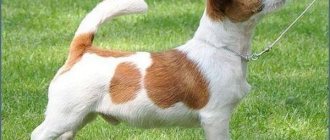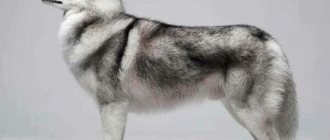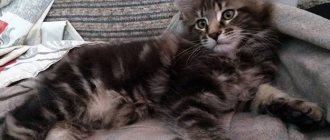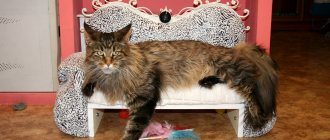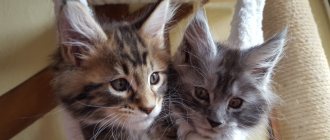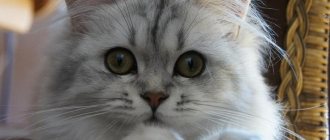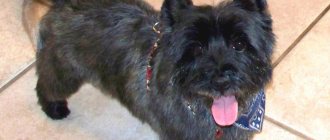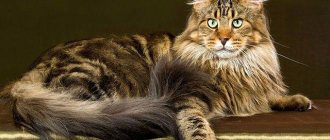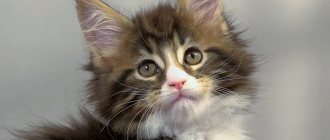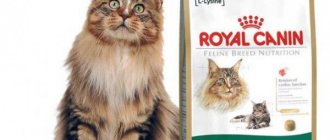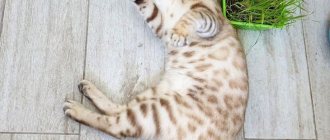Video “Maine Coons are the largest domestic cats”
The weight of a Maine Coon cat in adulthood is 5-8.5 kg, and males weigh more, their weight at the age of more than 3 years is 6-12 kg.
You can find out what the maximum weight of an animal is only if it is already more than 3 years old, because this is the age that these large cats grow up to. A one-year-old female can weigh 3.5 kg, and a male – 5-5.5 kg, but in subsequent years their weight increases. That is, the weight of a Maine Coon in adulthood, based on mathematical calculations, is about 6.8 kg for a cat and 9 kg for a cat. As we found out, the maximum weight of a Maine Coon cat is 12 kg, if we are talking about a cat, especially a neutered one. And Maine Coon girls weigh 8.5 kg maximum. However, such figures do not mean that such large cats (their body length can reach 120 cm from nose to tailbone) cannot weigh more.
Provided that the cat's owner does not monitor the amount of food he eats, the animal may well gain weight of 15 kilograms. However, this is not the norm, therefore we will not discuss Maine Coons with obvious obesity, because even an outbred cat can be fed up to 20 kg or more (such a case, by the way, is recorded in the Guinness Book).
Based on the above, it turns out that Maine Coons are not such giants. The same Siberian cats, ragdolls and British cats sometimes weigh even more than the average heroes of our article. But why exactly do Maine Coons look so much larger and bulkier than other cats? The point is a muscular body and fairly long limbs, luxurious fur and rich undercoat, a long and powerful tail, large ears with tassels, and finally.
In this video you will hear interesting facts about the Maine Coon breed.
By 15 months, the growth of the Maine Coon ends; until the age of three, domestic cats gain muscle mass. The weight of an adult male Maine Coon is 9-10 kg, a female Maine Coon weighs 7-8 kg. This is the average weight of the Mei Coon. Males are often larger than females, but some females can weigh more than yearling males. The weight of a Maine Coon can change after castration, since they do not have hormonal fluctuations.
Several of the largest coons in the world have been recorded. The largest Maine Coon seen at shows weighed 15 kg. But the exhibition organizers canceled the “fattest cat” nomination. Sometimes owners overfed their pets, which led to a shortened life of the cats.
Factors influencing the growth and development of a kitten
The main role in regulating body functions (including growth function) belongs to the endocrine system, namely the pituitary gland. The anterior lobe of the pituitary gland produces the growth hormone somatotropin. This biologically active substance ensures the growth of bones and cartilage, and takes part in the formation of muscle mass. No less important is the general hormonal background, which is created by the work of the thyroid gland, reproductive system and adrenal cortex.
There are several other physiological factors that shape the body’s ability to actively grow:
- Breed characteristics. Cats of small breeds go through physical development somewhat faster than their large relatives.
- Belonging to one gender or the other. Males gain weight more actively.
- Hereditary characteristics. The kitten adopts its character and growth characteristics from its parents. You can understand what an animal will be like at the peak of its development by looking at its mother and father.
The rate of physiological growth of cats is greatly influenced by the external circumstances and conditions in which they live and are raised, as well as the characteristics of their care:
- Habitat. If kittens grew up in a cold climate, with few sunny days, then their metabolism was slowed down. This means that they will lag behind in development from their relatives, who have lived their entire lives in the south.
- Lifestyle. Domestic cats living in warm conditions, receiving enough food and all the nutrients they need, have good immunity and develop faster than street animals.
- Amount of sleep and rest. The cat needs to sleep enough time. If in childhood animals are playful and active, then in adulthood the normal amount of sleep for them should be 17-20 hours a day.
- Physical activity also plays a role in development. The animal must be given enough space and opportunities to play.
- Hereditary and acquired diseases. Owners must take all measures to protect their pets from possible infections. In this sense, the importance of preventive vaccinations cannot be overestimated.
- Early castration and sterilization significantly pushes the limit of active growth. After surgery, the rate of growth and weight gain decreases significantly.
- Early pregnancy has a similar effect. After its onset, the priority for the body becomes bearing and then feeding the offspring.
Maine Coon weight norm
To begin with, we will tell you how much a cat weighs at different periods of life and how old representatives of this breed grow.
Kitten sizes
Let's find out how the Maine Coon develops month by month. The weight of a newborn Maine Coon kitten ranges on average from 100 to 180 g. A viable baby can weigh at least 80 g. The weight of kittens depends, among other things, on their number in the litter: the fewer there are, the larger they are.
A small Maine Coon (1 month old) is gaining weight at a particularly fast pace. By the end of this period, littermates are usually compared: those born weak and light catch up with the “strong ones.” At the same time, some difference in size between males and females becomes noticeable. Maine Coon kittens at 1 month weigh on average 560–740 g (girls) and 630–820 g (boys). A Maine Coon at 1–2 months should receive food 6 times a day.
Maine Coon kittens at 2 months slow down their development rate slightly. Partly due to the fact that at this time they gradually stop drinking easily digestible mother's milk and switch to independent feeding. A healthy 2 month old Maine Coon weighs between 1.1 and 1.5 kg. For a Maine Coon, 3 months is the period when teeth finish forming.
At this time, the kittens completely switch to self-feeding and their growth rate accelerates again. A baby with a good appetite can gain up to 0.5 kg per week. The normal weight of a Maine Coon at 3 months is from 1.7 to 2.3 kg. At this age, meals become four times a day.
For a Maine Coon at 4 months, the normal weight is 2.7 to 3.6 kg for a girl and 3 to 3.8 kg for a boy; at 5 months – 2.9–4.3 kg and 3.2–5.5 kg, respectively. At 6 months, a Maine Coon should already receive three meals a day. The portions are increased accordingly. Normal weight at this age is 3–5.8 kg. By the way, this weight is the maximum for some adult representatives of other breeds.
The older the animals become, the more pronounced the difference between different-sex representatives of the breed is. Thus, the weight of a healthy Maine Coon at 7 months is from 3.5 to 4.9 kg for cats and from 4.2 to 6.5 kg for males. Gradually, more and more products are introduced into the animal’s diet: lean meat, eggs, cottage cheese, etc. With normal development and a balanced diet, the weight of Maine Coons at 9 months is from 4.1 to 5.5 kg for girls and from 5.1 up to 7.2 kg for boys. At 1 year - 4.5–6.8 kg and 5.7–9 kg, respectively. At 2 years old, the female weighs from 4.7 to 7.3 kg, the male - approximately 10 kg.
People planning to get such a pet are usually interested in how old Maine Coons grow. Most often this happens before the age of three. After this, body weight and height stabilize and, with a balanced diet, remain practically unchanged. To monitor the development of the pet and its compliance with the norm, the owner will need a table of Maine Coon weight by month, and at first - by week.
So, the answer to the question “To what age does a Maine Coon usually grow?” is 3 years old. Let's find out what parameters are considered normal for a mature animal. For the Maine Coon breed, the weight of an adult uncastrated cat ranges from 9–12 kg. If the male is castrated, he can gain up to 13–16 kg.
We suggest you read: What to do if your cat urinates frequently
The length from the nose to the tip of the tail often reaches 1 m, the maximum officially registered is 1.23 m. A massive muscular physique, a large head with characteristic “lynx” ears, a fluffy tail and long hair visually “weight” these animals almost twice. Many are sure that the normal weight of representatives of this breed is about 20 kg.
Kitten sizes
Health of raccoon kittens
Since the Maine Coon cat breed is the result of a huge cat population and a source of genetic diversity, the health of the kittens is considered to be quite strong and hardy. However, any owner should monitor the health of their pet and know the most common diseases.
Diseases
Maine Coon kittens may exhibit the following genetic diseases:
- hypertrophic cardiomyopathy
- hip dysplasia
- spinal muscular atrophy
We suggest you read: How and under what conditions whales breed
In order not to worry about your cat in the future, choose it from responsible breeders who carefully monitor diseases and do not allow the breeding of sick animals. If you encounter genetic defects, be sure to conduct appropriate periodic examinations in veterinary clinics so as not to worsen the situation.
Vaccinations
It is very important to get Maine Coon vaccinations on time, even if your pet is indoors and does not go outside. The first vaccination must be given to a Maine Coon kitten at 2 months, the second at 3, and then at 1 year. Afterwards the vaccination is done once a year.
You should also know that there are cases when vaccination is simply necessary, for example: mating, cat exhibition, transporting a kitten.
Maine Coon teeth erupt for the first time at 2 weeks, but finally grow in by 3 months. Teeth change between 3 and 7 months. First, the incisors fall off, and only then the fangs.
To ensure that your little Maine Coon has healthy and strong teeth, provide him with a balanced diet and purchase toys that will help him sharpen his teeth.
First month
We know the average weight of a Maine Coon. What is the mass of these animals at birth and in the first months of life? Of course, even kittens of this breed weigh quite a lot: about 30-50 grams more than the cubs of the same British cats. So, let's look at the Maine Coon's weight by month:
- At birth - 100-140 g
- 1 month - 550-700 g
- 2 months - 1000-1400 g
- 3 months - 1600-2400 g
- 4 months - 2500-3600 g
- 5 months - 2800-4000 g
- 6 months - 3200-4200 g
- 7 months - 3600-4700 g
- 8 months - 3800-4900 g
- 9 months - 4100-5900 g
- 10 months - 4400-6500 g
- 11 months - 4500-7000 g
- 1 year or more - 5-8.5 kg
- At birth - 120-160 g
- 1 month - 650-750 g
- 2 months - 1200-1500 g
- 3 months - 2800-3700 g
- 4 months - 3100-3900 g
- 5 months - 3300-4200 g
- 6 months - 3900-4500 g
- 7 months - 4400-5600 g
- 8 months - 4500-6200 g
- 9 months - 4600-6800 g
- 10 months - 4800-7300 g
- 11 months - 5000-7500 g
- 1 year or more - 6-12 kg
Table
If we consider the weight of a Maine Coon kitten by month, it becomes obvious: young animals weigh differently. Even a newborn baby can weigh either 100 g or even a little less (the numbers in the table are approximate), or more than 150 g. Likewise, adult cats can weigh less than 4 kg, or more than 12 kilos. So, depending on your luck.
Maine Coon kitten weight table depending on age
| Kitten age | Cat weight | Cat weight |
| Newborn kitten | 100-140 g. | 120-160 g. |
| 1 Week | 160-230 g. | 190-250 g. |
| 2 weeks | 160-230 g. | 190-250 g. |
| 3 weeks | 420-550 g. | 440-600 g. |
| 1 month/4 weeks | 560-680 g. | 630-750 g. |
| 2 months/8 weeks | 1.1-1.4 kg. | 1.2-1.5 kg. |
| 3 months/12 weeks | 1.7-2.4 kg. | 2.8-3.6 kg. |
| 4 months/16 weeks | 2.7-3.6 kg. | 3-3.8 kg. |
| 5 months/20 weeks | 2.8-3.9 kg. | 3.2-4.2 kg. |
| 6 months/24 weeks | 3.2-4 kg. | 3.8-4.5 kg. |
| 7 months | 3.6-4.7 kg. | 4.2-5.6 kg. |
| 8 months | 3.8-4.9 kg. | 4.5-6.1 kg. |
| 9 months | 4.1-5.8 kg. | 4.6-6.8 kg. |
| 10 months | 4.3-6.5 kg. | 4.8-7.2 kg. |
| 11 months | 4.3-7 kg. | 5-7.5 kg. |
| 1 year/12 months | 4.5-8.3 kg. | 5.4-8.8 kg. |
| 5 years | 5-8.5 kg. | 5.8-12 kg. |
The first month is the most important period in the life of a little Maine Coon. Every day he must gain a certain amount of weight: in the first days - up to 10 g, in the second or third week - from 20 to 50 g.
By the end of the fourth week, the weight of males ranges from 620 to 750 g, females - from 520 to 650 g.
Over the next month, Maine Coon kittens develop rapidly. They become almost independent and grow quickly. Starting from the 5th week, pets are gradually weaned from breastfeeding by introducing complementary foods. They start with children's yoghurts, curds, kefir, constantly expanding the diet. By the end of the third month, animals completely switch to “adult” feeding.
In the second month of life, the weight of Maine Coons doubles. At the same time, the weight of the animal fluctuates slightly: the kitten either loses weight or gains weight again. Males weigh from 1.3 to 1.5 kilograms, females - from 1.1 to 1.3. By the end of the 12th week, females grow to 2.7 kilograms, females - up to 2.
As a rule, problems with weight gain do not arise during this period. If the kitten developed correctly in the first weeks, then it will not be underweight at this stage. Usually, on the contrary, you have to make sure that the Maine Coon does not overeat.
Maine Coon kittens gain weight most actively during the 4th and 5th months. At this age, pets are almost adults and completely independent. A growth peak is observed: the skeleton and muscles are finally formed, and teeth are replaced.
The energy needs of pets and, accordingly, the volume of portions increase. By the end of the fifth month, Maine Coon males weigh an average of 4 kilograms, females - about 3.
In order to clearly determine whether your pet is growing normally in size, the table shows the weight of kittens by month. As you can see, a Maine Coon at 1 month is already larger than a regular cat.
Up to a year, development occurs very quickly and a Maine Coon kitten weighs more than a kilogram at 2 months. Maine Coon kittens at 3 months are larger in size than some adult cats of other breeds. A Maine Coon at 4 months weighs up to 3.5 kg, and this is not the limit for them.
A Maine Coon at 5 months already exceeds 4 kg, which is quite rapid growth. The weight of a Maine Coon at 6 months is 5.3 kg for males. At 7 months they have the weight of an adult cat of most breeds. At 8 months the animal is heavier than 5.5 kg.
The weight of a Maine Coon at 9 months reaches 7 kg, and at just 10 months the cat already looks like a real giant. And at 1 year the pet’s weight reaches 8.5-9.5 kg, this is the time of the most powerful weight jump.
The size of the animal depends on many factors, do not be upset because your pet does not meet the standards; however, be vigilant and do not be negligent about the health of your pet.
What affects growth
Maine Coon animals must meet a certain standard when they reach the age of 2 years. An adult uncastrated cat of this variety should weigh about 9–12 kg (average). If the pet has been neutered, then it may weigh more - 13–16 kg. At the same time, the average height of a pet at the withers is usually about 25–40 cm.
Interestingly, the maximum recorded figure was 20 kg. The maximum body length of the animal from the tip of the tail to the nose was 1.23 m. Normally, this parameter is about 1 m.
We suggest you read: What treats can you give your puppy during training?
It is worth noting that this breed is characterized by sexual dimorphism. This means that the cat will be smaller in size than the male. Adult females of this species should normally weigh 7.5–8 kg. They are more graceful, although they also have well-developed muscles and long hair.
Maine Coon pets have a large head, muscular build, fluffy tail and “lynx” ears. All this, coupled with long hair, visually makes the animal heavier.
Are Maine Coons really that huge and how often do they lie about it?
It depends on who you compare these amazing animals with: if with other domestic cats, then yes, they are huge! If with dogs and other predatory felines, then no, they are not very big!
If they tell you that there are Maine Coons weighing up to 25 kg, don’t believe it, it’s a visual deception! These cats are very graceful, flexible and have light bones. They can appear huge due to the length of their tail and body, as well as their relatively thick coat.
In addition to gender, the weight and height of a maecoon depend on genetic factors, particularly the size of the mother. It is also important how well the cat ate during pregnancy. Illnesses and stress of a pregnant female also negatively affect the health and, accordingly, the size of the kittens. This dependence continues during lactation.
Medications taken either by the pregnant cat or by the babies themselves can change the rate at which a Maine Coon gains weight, up or down. The size of Maine Coon kittens is also affected by the size of the litter. If there is only one Maine Coon kitten, it can weigh up to 140 g; for two, the normal value decreases to 130–135 g.
If there are five babies in the litter, the normal weight for each will be 118–125 g. For the normal development of a Maine Coon kitten, good sanitary conditions and the absence of stress, such as sudden changes in temperature, drafts, intrusive attention from other pets or children, loud noise or music, etc. Strong excitement at this age changes the hormonal background of the kitten, which negatively affects the rate of its development.
It is important to introduce new foods into the diet in a timely manner. This pet can be fed with both natural and dry food. The transition from one type of power supply to another should be smooth.
The cat grows up to 3-4 years, during which time the body length reaches an average of 1 meter. Of the recorded records, the longest cat in the world is 123 cm. There have been cases when the animal reached 135 cm.
In cats, the height at the withers is 30-40 cm. Parameters such as the weight of the cat and its size do not depend only on the health and gender of the kitten. High-quality care and proper nutrition for Maine Coon cats, timely examinations, living conditions, these are the factors influencing the weight of the animal.
For boys and girls the figure is approximately the same. Meals should be divided into 4 servings up to a year and limited to 2 meals after. Do not feed the animal to a huge size; a fat cat is more susceptible to disease. Proper care not only ensures proper development, but also significantly prolongs life.
To grow and achieve maximum performance, Maine Coons must be kept in a certain favorable environment. The development of a kitten can be influenced by a number of factors, the largest domestic cat depends on the following circumstances:
- Genetic features. If the kitten's mother is in good shape, she is large and has a strong physical condition, then the growth rate of the kittens will be much faster.
- Floor. The difference in height and weight depends on gender, the male grows faster than the female, so the cat is heavier than Maine Coon cats.
- The use of hormonal drugs negatively affects weight gain and growth.
- Hygienic conditions in which kittens are kept.
- Impact of stress. If an animal regularly experiences stress, the influence of stress hormones negatively affects the endocrine system. Such exposure adversely affects growth. Kittens should have a full range of entertainment, and they also need to be protected from temperature changes and noise.
- The mother cat's diet should be balanced. Compliance with this condition will allow you to raise healthy kittens with good weight gain.
What is physiological growth
Physiological growth is the process of increasing body size and gaining muscle mass through continuous cell division. The answer to the question of how old cats grow is very ambiguous. The animal grows to the size required by its genetics and breed. For each age, there are certain norms for body size and weight, but there are also individual characteristics. Some physiological and external factors also influence the growth of animals.
In parallel with growth, the development of the cat’s body occurs, the formation and formation of all organs and systems. It is believed that furry pets grow and develop until puberty. Then, this process continues, but not so actively.
For what reasons does a cat baby not gain weight?
Maine Coons usually grow well and quickly, and by the age of 2 months their weight can reach 1.5 kg. But it also happens that the Maine Coon does not gain weight, which is not the norm. Reasons thought to contribute to poor weight and height gain include:
- Poor food for mother cat. Lactating female Maine Coons are fed at least 3 times a day with special food for lactating cats or food prepared by a caring owner (lean meat, fresh dairy products, cereals, occasionally fish and boiled eggs, vegetables and vitamins prescribed by a specialist);
- If the cat is still too small, he may simply weakly suck his mother's milk. Or the cat’s milk itself is not enough. To keep babies fed, some owners feed them with cat milk substitutes;
- Harmful (toxic) mother's milk. Milk can be dangerous if the animal suffers from mastitis, metritis, or uterine abscess - problems that are common after childbirth. The milk of an animal that is treated with any medications without the consent of a veterinarian is not at all beneficial;
- Lack of vitamins and anemia. If there are few useful components in mother's milk, Maine Coon babies can easily grow poorly and slowly, and be weak;
- Worms. These parasites are often transmitted to kittens from the mother through milk. Naturally, worms do not leave a chance for weight gain;
- Genetic deviation. It happens that among five kittens one weighs very little and looks too weak. This happens with people too, when one of the twins is in full health, and the other is on the verge;
- Disease. In fact, any disease that was transmitted to the baby from a cat or developed independently can affect weight gain. When the kitten is clearly not feeling well (stool problems, vomiting, temperature (normally it should be 38.5-39.5 degrees), discharge from the nose and eyes, plaintive meowing, etc.), you should quickly run to the veterinarian or call a doctor on house;
- Crossing a Maine Coon female with an outbred male. Usually such cases are excluded, but sometimes they still occur. A half-breed cat may well gain weight more slowly than its purebred counterpart.
The Internet is full of advice on what drug can be administered to a small Maine Coon. Trusting recommendations from cat forums is not always wise. Many medications can do more harm than good. In addition, without a correct diagnosis, treatment cannot begin.
Factors that influence the characteristics of the Maine Coon
Among other things, the height and weight of a Maine Coon are influenced by various factors:
- Pedigree purebred. The growth rate and initial weight of a kitten directly depends on the genetic characteristics of the breed.
- Floor. As kittens mature, they gain different amounts of weight. For example, by 7 months a kitten will weigh significantly less than a cat, and the same applies to growth.
- Dimensional characteristics of parents. If the mothers and fathers of the kittens are large, then large kittens can be expected in their litter.
- Hormonal imbalances. If therapy using hormonal medications is applied to a pregnant female, such treatment can negatively affect the kittens.
- Stressful situations. The nervous shock of a cat mother during pregnancy negatively affects the growth of future offspring.
- Feeding a cat during pregnancy. A balanced diet for a pregnant Maine Coon female is the key to the birth of healthy and strong offspring that meet the weight and height standards for representatives of this breed.
Overweight and underweight
If a Maine Coon has an average weight, this is an indicator of its harmonious development. However, some owners make the mistake of overfeeding the animal in an effort to raise a “record holder”. An obese Maine Coon, like any living creature, will soon develop health problems that can lead to early death.
We suggest you read: How many days does a cat walk with a cat? At what age does a cat begin to walk and when does it reach puberty?
In this case, you need to show your pet to a veterinarian. If there really is a problem, he will help determine its cause and prescribe appropriate treatment. It is important to track the development of small Maine Coons month by month. If the size and weight do not correspond to the age of the kitten, you need to review its diet and, if necessary, add more high-calorie foods, vitamins or nutritional supplements to stimulate appetite.
One of the reasons for excessive thinness may be a disease (for example, worms). If, after a certain time after changing the diet, the Maine Coon still does not gain the required weight, it should be shown to a specialist. If symptoms such as lethargy and depression, dull coat, etc. are observed, a visit to the veterinarian should be made immediately. You can also keep a chart of the Maine Coon's growth by month - body length and height at the withers should increase in proportion to body weight.
Why can a Maine Coon lose weight?
What should owners do if the weight of an adult Maine Coon cat is pathologically low? Especially when a pet that was bursting with health suddenly began to lose weight? The reasons for obvious weight loss may be as follows:
- The presence of parasites in the animal’s body (both external and internal);
- Stress;
- Diet poor in nutrients;
- Hormonal disbalance;
- Sudden change in diet;
- Ailments (diseases of the stomach, intestines, etc.);
- Oncology.
In addition to weight loss, the cat should also have other alarming symptoms, for example, constipation, interspersed with diarrhea due to helminthic infestations. Or atypical and restless behavior when experiencing stress.
What is the standard weight and size of the breed?
Newborn Maine Coon kittens can have different weights - from 100 to 160 g, but by 2-3 months they grow noticeably. You can recognize a small Maine Coon by its strong build and massive head. The tail looks quite wide, long and bushy. By the way, Maine Coon kittens should have all their fur fluffy and thick. A distinctive feature of a kitten of this breed is its prominent ears with tufts of hair at the tips. There are a lot of colors for Maine Coons.
From this video you will learn about the characteristics of Maine Coon cats and how to care for the breed.
The exterior of the Maine Coon is unique; there are no exact analogues of such a cat anywhere in the world (see the largest Maine Coon in the world).
Description of the Maine Coon breed:
- The body is elongated and large. The neck and chest are wide.
- The tail is approximately equal to the length of the body.
- The head is large, high-set ears with tufts at the tips, a sharp convex chin, narrow, relatively small “live” eyes (compared to the large head).
- The eyes are located close to each other on a wide muzzle. Some lovers of the breed jokingly call the face of these cats a “felt boot face,” since the nose and jaw are noticeably pushed forward from the base of the head.
- The eye color is predominantly golden. Sometimes greenish, amber, light orange, or yellowish colors are found, extremely rarely - blue or light blue.
- The coat is thick, long, growing along the body.
- The areas of the body with the longest hair are the back, belly, and sides of the hind legs. Short hair grows mainly on the head, neck, and shoulders.
How to choose a kitten
To choose the right Maine Coon kitten, you should first study the breed standards according to the European and American versions of the systems, and also visit several exhibitions. After this, you can confidently go to the nurseries that you like.
- If you wish, you have the right to look at the kitten’s parents and ask about their veterinary passports and pedigrees.
- If the cattery has other popular cat breeds, breeders may offer mixed breeds or crossbreeds. Of course, they can be wonderful and cute, but they will no longer be considered real Maine Coons.
- If you are offered a show class kitten with no breeding restrictions, then most likely you are again being offered a cross between two breeds.
- Pay attention to the character of the Maine Coon. He should not be intimidated or aggressive.
- You can buy a kitten only after 3 months, when the mother cat has passed on the necessary animal skills to it.
What to name a Maine Coon kitten
Description of the Maine Coon breed, its main characteristics
Rumor has it that these cats appeared by crossing a cat and a raccoon. According to another version, the ancestors were the lynx and the domestic cat. These extraordinary individuals are very beautiful; a rich palette of colors and large sizes are their distinctive features. You can meet black, white and red representatives of the breed. His pride is his fluffy tail and original tassels on his ears.
The little animals also have an unusual character: they love to play fun and funny, touching the owners, and are also always ready to help and defend themselves. They are curious and very cute, friendly and not at all aggressive, they hardly let out their claws, they love affection and tenderness.
Cats of this breed can be trained without problems, they value space at a high level; adults are distinguished by laziness, although they are curious in everything. They greet guests themselves and know more about every detail in the house than you do. Once you buy a new thing, it will immediately be noticed and studied.
